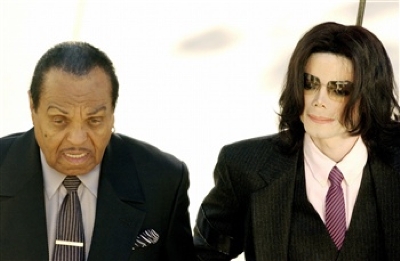Notes
An Outside Look At Neverland

I'm disappointed with myself for having posted a picture of Michael Jackson. I don't know what got into me. The last thing I remember, I was looking for an image to analyze for International Women's Day.
I've been tracking back, trying to figure out how I got here. I remember, I had been thinking about faces. How everything these days is about face. About spin. About surface. About looking at everything from the outside.
Maybe I ended up here having spent last night considering how The Economist had visually sexed up the democracy protests in Beirut. Or maybe, the theme really got rolling this morning, when I woke up to find the new Newsweek sporting its own Lebanese shoulder-riding cover girl.
Prior to that, I know I had been reading about Vanity Fair, which — having suffered a circulation wrinkle as a result of too many men gracing the cover for too many months — had tightened things up by featuring the supermodels of Eastern Europe on the front of their latest edition.
Perhaps that somehow reminded me of the column Maureen Down wrote the other day, spawned by the Academy Awards, speculating how the plastic surgery boom (which seems to have reached a fever pitch here in L.A.) might be leading to a day when everyone (meaning, men too?) would all have the same face.
Which might have gotten me thinking, again, about the shot I analyzed of Laura Bush in Philly, with those inner city kids at the Boys and Girls Club, where she is craning her neck toward the camera, the way a plant orients itself to the light.
Which I was also thinking about today after a BAG reader, Jason, sent me the most recent image of Laura's 'Save Our Poor Inner City Youth' campaign. In the NYT story of the event, in Allegheny County, Pennsylvania, there is a photo of Dubya at a low desk, with his face literally in the face of a small African-American girl, while Laura beams nearby.
Preceding that, I had been looking at the latest Martha Stewart shot on the front of the morning's NYT Business section (in a presentation to her employees, she was showing off a poncho presented to her by a fellow prison inmate) when, directly above Stewart, I noticed a photo and article about Jane Fonda. What captured my attention was that Jane's face had been nearly restored to the one she had owned in Barbarella –while the rest of her figure seemed to more closely approximate Penelope Cruz.
Of course, this is what preceded my International Women's Day hunt. So what followed?
I know I spent some time studying an image of cloaked Turkish women marching through central Istanbul past a two story tall Swatch advertisement featuring brown cream-skinned women in racy western dress. I also admired a protest shot featuring two Mexican prostitutes, one with died red hair, hiding behind a tribal mask. They were carrying a banner of a dashing woman, as elegant as if it had come off a Rivera mural.
Not having found quite the right thing, however, I landed on the Reuters site, clicked through the featured pictures of the previous 24 hours, and ended up in the middle of the Michael Jackson show. I won't dwell on the bizarre courthouse scenes I saw there (including one of an aging Gary Coleman, carrying a microphone sporting a logo for something called Comedy Radio, or a pic of Michael in the back seat of a limo, looking miserable, with his brother smiling and beaming out the window like it was his lucky day). But it's where I found the image above.
(Just to be clear, this is likely my first and last post on Michael Jackson — if this post even has to do with Michael Jackson. Or maybe, in a weird kind of way, this is my commemoration of International Woman's Day.)
Regardless, I'm still slightly unclear what drew me to this photo. Unless it was that smudge in the white backdrop.
I don't know what else it could have been. I know I can't look at Michael. I also didn't see a lot of meaning in the visual contrast between him and his father: the folded skin as opposed to the bleached and stretched; the grey shirt juxtaposed with the pinkish-white one; the black tie versus the purple one. And I also couldn't see any special significance in the more dynamic distinctions: the older versus younger; the darker beside the lighter; the more forward and expressive compared to the more set off, mute and spectacled.
Really, all I could see was that shadow, that dark little minus sign of a smudge on that ultra-white background, floating like a U.F.O. between the two men.
If I really think about it, maybe what is compelling about that smudge is how much it seems to mar an otherwise perfectly good picture. In fact, maybe that is how these preoccupations start. You see the smudge, the imperfection, the little flaw. Then, pretty soon, you can't see anything else. You try to own it, rationalize it, even forget about it, but your mind keeps playing games. Finally, a little put out by the whole thing, you start considering other options. Maybe you promise yourself, if you could do something about it, make just one little alteration, everything would be right.
(image: REUTERS/Aaron Lambert)


Reactions
Comments Powered by Disqus